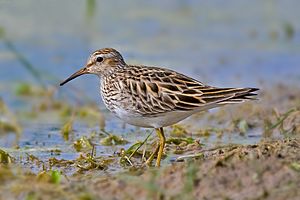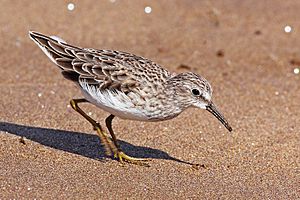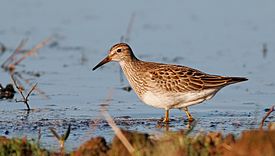Pectoral sandpiper facts for kids
Quick facts for kids Pectoral sandpiper |
|
|---|---|
 |
|
| Adult in breeding plumage | |
 |
|
| Adult non-breeding | |
| Conservation status | |
| Scientific classification | |
 |
|
| Synonyms | |
|
Actodromas maculata |
The pectoral sandpiper (Calidris melanotos) is a small bird. It is a migratory wader. This means it travels long distances and lives near water. These birds breed in North America and Asia. They spend their winters in South America and Oceania. Pectoral sandpipers eat small invertebrates. These are tiny creatures without backbones.
Their nest is a hole in the ground. It has a thick lining. This deep nest protects its four eggs. It keeps them safe from the cool winds where they breed. A pectoral sandpiper is about 21 cm (8.3 in) long. Its wings can spread up to 46 cm (18 in) wide.
Contents
Bird Family Tree: Understanding Pectoral Sandpipers
The pectoral sandpiper belongs to a group sometimes called "stint" sandpipers. Scientists group birds based on how they are related. This helps them understand bird families. The scientific name Ereunetes was used before Erolia. It refers to other small sandpipers.
Sometimes, a "Cox's sandpiper" is seen. This is a hybrid bird. It is a mix between a pectoral sandpiper and a curlew sandpiper. This does not mean they are super close relatives. Other different waders can also have hybrid babies. Among the "stint" group, the red-necked stint and the long-toed stint are close relatives of the pectoral sandpiper.
The scientific name comes from Ancient Greek. Kalidris or skalidris was a word used by an old Greek thinker, Aristotle. It meant some gray birds near water. The word melanotos means "black-backed." It comes from melas (black) and notos (backed).
What Does the Pectoral Sandpiper Look Like?
This bird looks a bit like the sharp-tailed sandpiper. But the sharp-tailed sandpiper is not in the same family group. The pectoral sandpiper is a fairly large calidrid bird. It is about 21 cm (8.3 in) long. Its wingspan is about 46 cm (18 in).
It has a grey-brown back. This back looks browner in summer and grayer in winter. The pectoral sandpiper has a grey chest. This chest has a very clear, sharp line at the bottom. This line gives the bird its English name. It is easy to see when the bird faces you. Its legs are yellowish. The bill is olive green with a darker tip.
Young pectoral sandpipers look brighter. They have reddish colors on their upper parts. They also have white stripes on their back.
This bird is different from the sharp-tailed sandpiper. You can tell by its chest pattern. It also has a weaker "eyebrow" stripe above its eye. Its head is also grayer.
Pectoral sandpipers are about 200–240 mm (8–9.6 in) long. They weigh around 73 g (2.6 oz). Their wingspan is about 460 mm (18 in).
Where Do They Live and What Do They Do?

This bird travels very long distances. About half of these birds breed in the wet, marshy tundra of northeast Asia. The other half nests from Alaska to central Canada. Most American and Asian birds spend winter in South America. Some Asian birds winter in southern Australia and New Zealand. When migrating or in winter, they like freshwater areas.
Pectoral sandpipers also visit western Europe regularly. They are seen almost every year in Ireland or Great Britain. They do not breed in Europe. But some stray birds have been seen in Scotland in summer. Many birds in Western Europe might be traveling from Asia to winter in Southern Africa. In September 2003, many birds arrived in Ireland (40) and Great Britain (150). This was a record number.
On the US Pacific coast, large groups of migrating birds are less common. Sometimes, stray birds are seen far from their usual routes. This includes places like the Marianas, the Marshall Islands, and Palau. They are seen a bit more often in the Hawaiian Islands.
The migration of these birds might be changing. This could be due to global warming. Many birds that breed in the Arctic are affected. One hundred years ago, pectoral sandpipers passed through northern Ohio in early May. They returned in late August. Today, they travel north in April. Most do not return until mid-September.
These birds look for food in grasslands and muddy areas. They find food by seeing it. Sometimes they poke their bills into the mud. They mostly eat arthropods. These are insects and spiders. They also eat other small invertebrates.
The male bird has a special dance to attract a mate. He puffs up his chest. During breeding season, he has a fat sac on his chest. This makes his display even bigger.
The pectoral sandpiper builds a deep, cup-shaped nest. It uses a lot of soft material to line it. The nest is deep enough that the eggs sit about 3 cm (1.2 in) below the ground. This helps keep the eggs warm. It protects them from the cool winds where the birds nest. The female lays four eggs.
The number of pectoral sandpipers has gone down. Their population has decreased by 50% since 1974.
Calidris melanotos in Field Guide: Birds of the World on Flickr species name is missing
See also
 In Spanish: Correlimos pectoral para niños
In Spanish: Correlimos pectoral para niños



